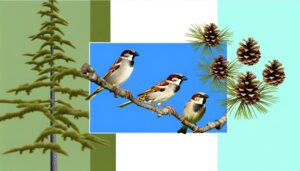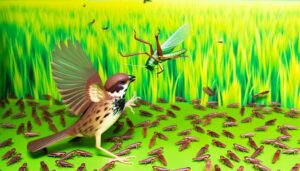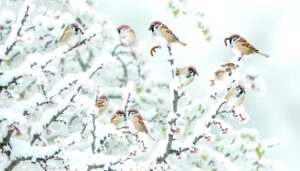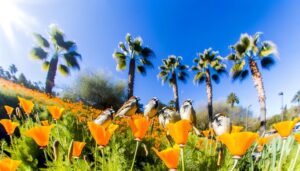How Do You Spell Savannah Sparrow Correctly?
The correct spelling for the North American bird species is Savannah Sparrow. Remember that 'Savannah' has double 'n' and 'Sparrow' has double 'r'.
It's not unusual to see misspellings such as 'Savanah Sparrow' or 'Savannah Sparo', but these are incorrect. The bird's name offers a glimpse into their origins and features, hinting at an intended association with grasslands or open fields.
With a deeper look into the bird's taxonomy, physical traits, behavior and conservation status, one gets a better understanding of this versatile species. There's more to the Savannah Sparrow than just its name!
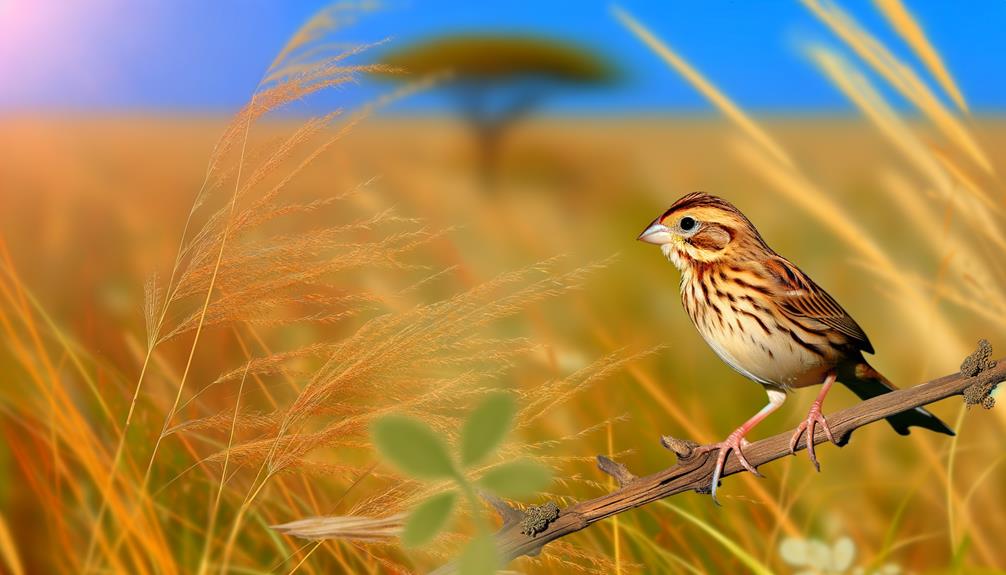
Key Takeaways
- 'Savannah Sparrow' is spelled with two words, both starting with 'S' and having seven letters each.
- 'Savannah' is a palindrome with a double 'n' in the middle, while 'Sparrow' contains a double 'r'.
- Avoid common misspellings like 'Savanah', 'Savanna', 'Sparow', or 'Sparo'.
- Understanding bird taxonomy and classification can help rectify spelling errors and enhance bird knowledge.
- Details like the bird's distinctive physical features, behavior, and geographical distribution also add context to its name.
Understanding Bird Names
Often, the names of birds, like the Savannah Sparrow, offer intriguing insights into their habitats, behaviors, or distinctive physical features.
For instance, the Savannah Sparrow's habitat is primarily grasslands, similar to the savannahs of Africa, reflecting its name. This bird's behavior also aligns with its name, as it's known to be quite active, much like the bustling ecosystems of savannahs.
Additionally, its distinctive physical features, characterized by streaked brown feathers and a small, notched tail, further imitate the wild, rough textures of the savannah landscapes.
Understanding the name of this bird isn't just about spelling it correctly, but about appreciating the rich tapestry of information it provides about the creature's existence.
Origin of 'Savannah Sparrow'
Surprisingly, the name 'Savannah Sparrow' doesn't originate from the African grasslands as one might assume, but rather, it's named after Savannah, Georgia, where the bird was first identified and documented scientifically.
When it was discovered in the 18th century, the ornithologists marveled at its distinctive plumage and melodious song. They named it to acknowledge its place of discovery, creating a lasting link between the bird and the Georgian city.
Over the years, this bird has spread to various regions, adapting to different habitats, yet it carries the name 'Savannah' as a nod to its historical roots. Even though it's found in various places, from grasslands to marshes, it's commonly recognized as the 'Savannah Sparrow', a tribute to its origin story.
Correct Spelling Breakdown
Let's dissect the spelling of 'Savannah Sparrow', ensuring we get it right every time.
The term 'Savannah Sparrow' is a compound name comprising two individual words: 'Savannah' and 'Sparrow'.
'Savannah' is a seven-letter word starting with 'S', followed by 'a', then 'v', another 'a', 'n', 'n' again, and an 'a' to close. It's a palindrome, meaning it reads the same backwards as it does forwards.
'Sparrow', on the other hand, is a seven-letter word starting with 'S', followed by 'p', 'a', 'r', 'r', 'o', and 'w'.
Both words are pretty straightforward, but they can trip you up if you're not careful. Remember, 'Savannah' has a double 'n', and 'Sparrow' has a double 'r'.
Common Misspellings Addressed
Common missteps in spelling 'Savannah Sparrow' frequently involve the double letters in each word, demonstrating a common linguistic pitfall.
Many tend to misspell 'Savannah' as 'Savanah' or 'Savanna', neglecting the second 'n' or 'h'. Similarly, 'Sparrow' often becomes 'Sparow' or 'Sparo', where the second 'r' or 'w' is overlooked.
These errors can be attributed to orthographic interference, where one's knowledge of how to spell similar words hinders the correct spelling of a new term. Additionally, phonetic misspellings such as 'Savanna Sparo' occur due to variances in regional pronunciation.
These common errors underline the intricacies of English spelling and the need for careful attention to detail when learning and using ornithological terminology.
Learning From Examples
Learning from examples can greatly enhance one's understanding of bird classification, specifically in the case of the Savannah Sparrow. By closely examining the distinguishing features of this particular species, individuals can glean valuable insights into the complexities of avian taxonomy.
This practical approach not only deepens the comprehension of the subject matter but also helps to rectify common spelling errors associated with the name 'Savannah Sparrow'.
Understanding Bird Classification
Bird classification, specifically the process of identifying the Savannah Sparrow, offers fascinating insights into the complexity and depth of avian taxonomy. This classification system, called ornithological taxonomy, is based on shared physical characteristics and genetic markers among bird species.
Distinguishing a Savannah Sparrow, for example, involves looking at specific traits like plumage patterns, size, and behavior. The science behind this taxonomy is intricate and detailed. It involves the examination of feather structure under a microscope, DNA analysis, and meticulous observation of behaviors.
This system, although complex, is essential for understanding the relationships between different bird species. It's the foundation for bird conservation efforts and provides a deeper understanding of avian biodiversity. This classification process is a tribute to the richness and diversity of bird species worldwide.
Exploring Savannah Sparrow
Delving into the world of the Savannah Sparrow, we'll explore this bird's unique markings, behaviors, and breeding habits to understand its place within the avian kingdom.
This medium-sized sparrow has a brown back with black streaks, a white belly, and a distinctive yellow stripe over its eyes. It's known for its melodious song that varies greatly between different populations. They're not picky eaters, feasting mainly on seeds but also insects during breeding season.
Savannah Sparrows nest on the ground, hidden among grasses or at the base of shrubs. Females lay 3-6 eggs and are the primary caregivers.
Understanding these attributes unravels the Savannah Sparrow's remarkable adaptability, helping it thrive in its diverse habitats across North America.
Homonyms and Confusions
In the field of ornithology, homonyms can cause significant misinterpretations, especially when it comes to bird names like the Savannah Sparrow.
It's not uncommon to confuse these names, as many share similarities, leading to frequent spelling mistakes.
This segment will explore understanding these homonyms, common confusions, and strategies to avoid spelling errors.
Understanding Homonym Misinterpretations
Surprisingly, many people often confuse homonyms, creating misinterpretations that can lead to important misunderstandings in communication. Homonyms are words that sound alike but have different meanings.
This similarity in pronunciation often leads to confusion, especially in spoken communication. For instance, the words 'bare' and 'bear' are homonyms, but their meanings are vastly different.
Misinterpretation of homonyms can distort the intended message, sometimes resulting in humorous or embarrassing situations. It's vital to understand the context in which the word is used, as it provides clues about the intended meaning.
Knowledge of homonyms and their correct usage can greatly improve both written and verbal communication. It's essential to learn and understand homonyms to prevent misinterpretations and enhance effective communication.
Commonly Confused Bird Names
Moving from the broader scope of homonyms, we find a specific example in the world of ornithology where bird names like 'Savannah Sparrow' often lead to confusion due to their phonetic similarity to other bird names. Ornithological nomenclature, although scientifically ordained, can pose challenges for bird watchers, ornithologists, and nature enthusiasts alike.
This phonetic ambiguity often leads to misidentification, causing a ripple effect in data recording and species conservation efforts.
- Savannah Sparrow vs. Vesper Sparrow: These species possess similar plumage and are often confused due to their overlapping habitats.
- Redpoll vs. Red Pole: This confusion stems from phonetic likeness; the former is a bird species, while the latter is a descriptor for birds with reddish poles.
- Mallard vs. Mottled Duck: These species exhibit similar color patterns, leading to frequent misidentification.
Avoiding Spelling Mistakes
To sidestep the pitfalls of spelling errors, particularly with homonyms and commonly confused bird names, one must familiarize themselves with the nuanced differences in ornithological nomenclature. A methodical approach to learning and applying these distinctions is pivotal.
To illustrate, the Savannah Sparrow shouldn't be confused with its distant relatives—Vesper Sparrow or Song Sparrow. Though they share similarities, each bird carries its own unique identity, reflected in their names.
It's important to note that words like 'Savannah' and 'Savanah' might seem deceptively identical, but the former is correct. Such homonyms can lead to confusion. It's crucial to be meticulous when spelling bird names. This not only guarantees accuracy but also enhances one's understanding and appreciation for the rich diversity in avian species.
Savannah Sparrow's Physical Characteristics
Boasting a distinctive profile, the Savannah Sparrow sports a small but sturdy build with a round head, short tail, and a somewhat thick beak that's perfectly adapted to its seed-eating habits. It's an agile bird with brown upperparts streaked with black, while its underparts are a clean, pale gray. Markings are pivotal in identifying this species, with its yellowish-brow stripe and white eye-ring being particularly noticeable features.
This bird's plumage isn't only practical for camouflage but also serves as a striking visual display.
The Savannah Sparrow's eyes are dark and sharp, enabling it to spot seeds and insects efficiently.
Its legs are a strong, pinkish hue, designed for hopping and perching.
With these physical characteristics, the Savannah Sparrow is well-equipped for its lifestyle, demonstrating the beauty of nature's adaptability.
The Bird's Geographic Distribution
Spanning across a wide range, the Savannah Sparrow inhabits various regions of North America, Central America, and South America, showcasing its adaptability to diverse environments. It's particularly widespread in the United States and Canada during the breeding season, from Alaska's tundras to the grasslands of the East Coast.
In winter, they migrate to warmer climates, reaching as far south as Mexico and the northern regions of South America. The bird's ability to thrive in various habitats, from coastal salt marshes to agricultural fields, attests to its remarkable adaptability.
Regardless of location, the Savannah Sparrow prefers open habitats with low vegetation. This broad geographic distribution reflects the species' ecological versatility, a key aspect of its survival strategy.
Savannah Sparrow's Unique Behaviour
The Savannah Sparrow exhibits distinctive habits that set it apart from other species. Scientists have spent years meticulously observing and documenting these behaviours, highlighting the bird's unique way of interacting with its environment.
Next, they'll scrutinize the Sparrow's communication methods, aiming to decipher the intricacies of their calls and songs.
Sparrow's Distinctive Habits
Savannah Sparrows exhibit a fascinating array of unique behaviors, including a complex song structure and an intriguing migratory pattern. These tiny birds exhibit certain habits that make them stand out in the avian world.
Some of their distinctive habits include:
- Their specific nesting habits. Unlike many birds, they construct their nests on the ground, hidden amongst tall grasses and weeds.
- Their unusual feeding habits. These sparrows prefer to forage on the ground, hopping around in search of food. They primarily consume insects and seeds.
- Their migratory behavior. Savannah Sparrows undertake long-distance migrations. They spend their summers in northern areas like Alaska and Canada, and winter in the southern United States and Mexico.
These behaviors reflect their adaptation to specific ecosystems, contributing to their survival and success.
Understanding Sparrow Communication
One intriguing aspect of the Savannah Sparrow's unique behavior is their complex communication system. Particularly, their song structure is a key component that they use for various purposes such as mating and territory defense.
Each male sparrow has a unique song, characterized by consistent syllable patterns, that they learn from their surrounding environment during their formative period. This song acts as an identity, differentiating them from other sparrows, and attracting potential mates.
Females, on the other hand, exhibit preference for males with complex songs, equating it to superior genetics and importance. Additionally, these songs serve as a warning to other sparrows, establishing the bird's territory.
This intricate communication system reflects the sparrow's advanced cognitive abilities and social structure.
Conservation Status of Savannah Sparrow
Despite facing dangers from habitat loss, the Savannah Sparrow's conservation status currently stands as 'Least Concern' on the International Union for Conservation of Nature (IUCN) Red List. This means that the species is widespread and abundant, though it's not immune to threats.
To maintain interest, consider these points:
- The Savannah Sparrow's extensive distribution across North America aids its survival, as it can adapt to various environments.
- Its large population size offers some protection against significant declines.
- Conservation efforts focus on safeguarding habitats and reducing threats like pollution and climate change.
It's important to understand that 'Least Concern' doesn't mean no concern. The Savannah Sparrow, like all wildlife, needs ongoing conservation efforts to secure its survival.
Fascinating Facts About Savannah Sparrow
Surprisingly, there are a handful of fascinating facts about the Savannah Sparrow that really highlight its unique characteristics and adaptability.
This bird species can vary greatly in size, color, and song based on its geographical location. It's known to have a high level of phenotypic plasticity, which means it can alter its physical traits in response to its environment.
The Savannah Sparrow's diet is also quite versatile, consisting mainly of insects during breeding season and switching to seeds in the winter. They're also known for their distinct song, which is often a series of high-pitched notes followed by a buzzy trill.
Despite their small size, they've proven to be resilient and adaptable, further demonstrating their intriguing nature.
Conclusion
In the grand tapestry of nature, the Savannah Sparrow holds its own unique thread. This bird, correctly spelled as 'Savannah Sparrow', is more than just a name. It's a tribute to the intricate beauty of our world.
A feathered reminder of why we must continue to nurture and protect our environment. So, when the day's hustle and bustle gets overwhelming, take a moment to appreciate this little bird. After all, it's the small wonders that often make life truly fascinating.

